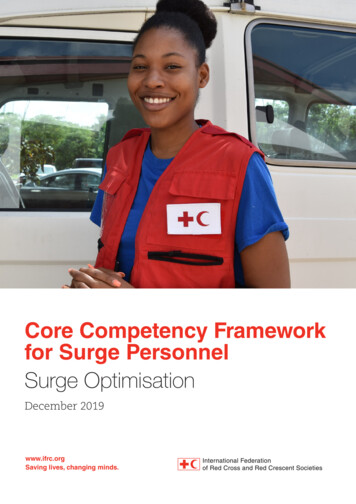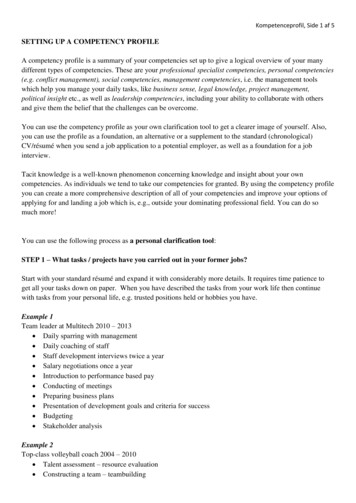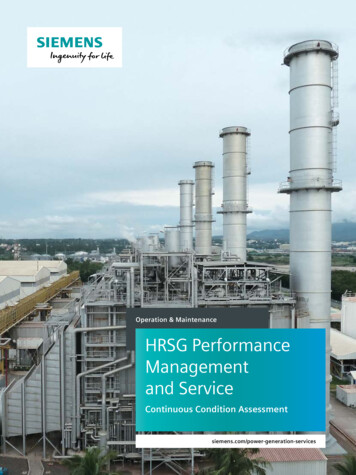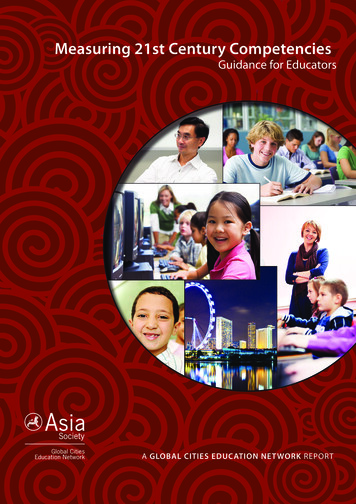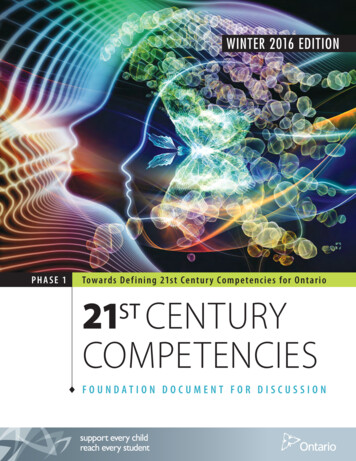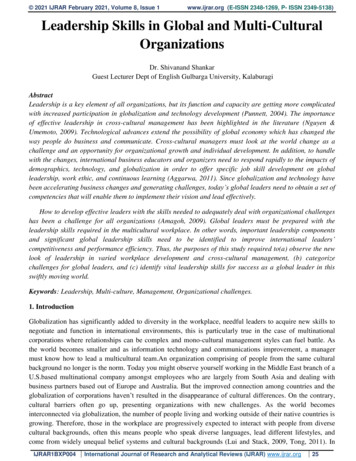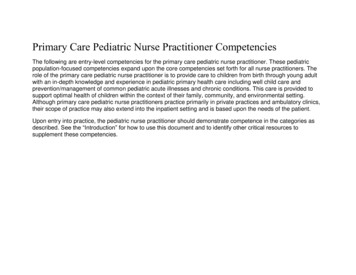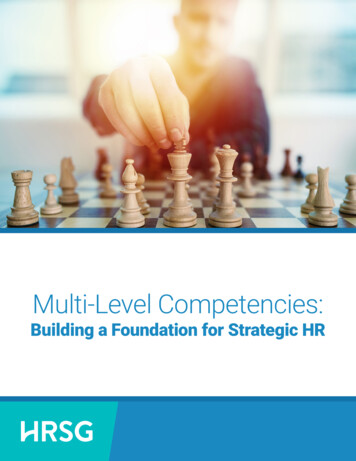
Transcription
Multi-Level Competencies:Building a Foundation for Strategic HR
Today, virtually every organization with morethan 300 people uses some form of competencybased human resource management.1Why have competencies emerged as thegold standard for talent management?The first reason is that they work. Research shows thatcompetency-based selection leads to lower turnoverand higher performance2. A 2009 study showed thatorganizations using core competencies enjoy greaterprofitability, customer satisfaction levels, and customerretention than other organizations3.Companies that usecompetencies enjoy:63% reduction in turnover,improvement in19% employee performance,12.5% increase in sales & profits .4The second reason is that they inspire. In over 25 years of competency-based engagements, HRSGhas seen the remarkable impact competencies can make on the sense of autonomy, empowerment,focus, and pride that employees develop as a result of a better, clearer understanding of their role andtheir potential within the organization.Competencies are effective because they go beyond the basic requirements of a job to identifythe behaviors that top performers demonstrate. Instead of focusing on WHAT a person typicallydoes on the job, competencies describe HOW a highly effective worker will achieve success. Mostimportantly, competencies describe those successful behaviors in terms that are OBSERVABLE.This enables HR professionals and managers to rely on objective criteria and measurable resultsrather than intuition and conjecture when evaluating and supporting performance. It also gives thewhole workplace — HR, managers, employees, and executives — a shared language for discussingand understanding workplace requirements and performance.Who uses competencies?Hewlett Packard, Google, United Nations, Pepsico, Volvo, McDonald’s, Starbucks, American Express,Johnson & Johnson, Coca-Cola, Toyota, Bank of America, BP, Wells Fargo, General Motors, HP, RadioShack, HCA, Carlson Companies, BHP, IBM, General Electric, PDVSA, Anheuser-Busch, Girl ScoutsUSA, US Federal Reserve, KPMG, Sanofi, Ingersoll-Rand, Lockheed Martin, Konica Minolta, Luminant,Prudential, Invensys, ConAgra, Expedia, DuPont, General Mills, Schlumberger, Grainger, and many more.1Boyatzis, R. E. (2008). Competencies in the 21st century. Journal of Management Development, 27(1).2 Rathbar-Daniels, Erickson, & Dalik. (2001). Here to Stay: Taking Competencies to the Next Level. Worldatwork Journal.3. Aberdeen, 20094. Spencer, L M. in Cherniss, C. and D. Goleman, eds. (2001) “The economic value of emotional intelligence competencies and EIC-based HR programs”, in The EmotionallyIntelligent Workplace: How to Select for, Measure, and Improve Emotional Intelligence in Individuals, Groups and Organizations. HRSG All rights reserved.—2—
Single level. Multi-level. What’s the difference?While competencies are widely used to manage talent, thereis still confusion around the different types of competencycontent available.Many HR professionals use some form of competency-based management within the organization.Those who work in large organizations with extensive HR resources may develop their own competencycontent in house. Others choose to purchase or license the use of competency content fromcompetency specialists such as HRSG.Whether they create content internally or purchase it from an external source, the most valuablecompetencies are those that articulate multiple, progressive levels of proficiency, from entrylevel to mastery.Why do multi-level competencies perform so much better as atalent-management tool?Because they provide greater detail, continuity, and simplicity than single-level competencies, andthese enhancements make competencies more practical and more versatile in the workplace.Greater simplicityMany HR professionals assume multi-level competencies are more complicated to use. In fact, theopposite is true. For example, instead of applying three single-level competencies to three differentjobs, you can assign different levels of the same competency. This approach allows you to streamlinethe number of competencies you work with while achieving the depth and flexibility you need. HRSG All rights reserved.—3—
With multi-level competencies, you have clearlydefined behaviors that are expected at different jobsor job levels. The clarity of those definitions facilitatesan objective evaluation for the manager, and providesa framework for meaningful discussions between themanager and the employee.— Lorraine MacKay, Senior Vice-President,Professional Services, HRSGBetter communicationBreaking a competency into progressive levels of proficiency provides more accuracy and allowsmanagers and employees to see how a competency is expressed differently depending on theamount of experience, skill, and aptitude required for a particular job. This additional detail andcontext provides a shared language during discussions about performance and greater accuracywhen talking about specific workplace behaviors and expectations.More empowered employeesBy enabling employees to see how the same competencies are expressed at different proficiencylevels for other jobs, multi-level competencies help them explore their potential and work towardslateral or upward career progression.Better HR coordinationMulti-level competencies connect jobs at every level — from entry to leadership — across theorganization. Each competency level describes the observable skills for a specific job, but onecompetency can link different jobs vertically or laterally across the organization. This helps HRprofessionals manage talent management more holistically and evaluate the organization’scurrent and future talent needs more confidently. HRSG All rights reserved.—4—
Anatomy of a multi-level competencyWhat does a multi-level competency look like? This example ofan HRSG competency for “client focus” provides a detailed look atthe functional components.31241The competency definition provides a high-level description of the competency.2The proficiency scale provides multiple proficiency levelsfor each competency. Each level reflects a progressionfrom a basic demonstration of the competency towards amore complex and strategic demonstration. For example,an entry-level employee may need to demonstrate level 1proficiency, while an executive may need to demonstrate level4 or 5. Proficiency scales help you compare requirementsacross jobs, which is especially useful when determiningpotential career paths within the organization.3The notion for each level provides a high-level summary ofthe overall theme identified for that proficiency level.4A behavioral indicator provides a clear description of theobservable behaviors that an employee will demonstrateon the job. HRSG All rights reserved.—5—Why five levels?Why do the majority of HRSGcompetencies include five levels—and not three or seven or ten?This model is based on extensiveexperience across a wide range ofsectors and HR processes. Nearlythree decades of competencybased engagements have shownus that five levels provides enoughdetail and differentiation toenhance accuracy, while avoidingunnecessary complexity.
Taking the first stepMuch has been written about the benefits of multi-levelcompetencies. But it’s harder to find information on justgetting started.There’s no shortage of research available about competency-based HR management processes.But because the research often focuses on mature processes, it usually doesn’t address theinitial implementation from the ground up. As a result, while most HR professionals recognize thevalue of competencies, many are unsure how to begin integrating competencies into their talentmanagement practice.In fact, taking the first step is simple. Whether you choose multi-level or single-level competencies,and whether your objective is to manage change, strengthen organizational culture, improve retention,or anything else, the first step is always the same — develop job profiles.Job profiles are the foundation on which all competency-based activities are built, because theyidentify the specific competencies and proficiency levels that define success for a specific job.This makes competencies concrete and tangible in the workplace, giving you a common languagefor describing successful performance, whether that’s in the context of hiring, performancemanagement, career progression, or any other HR activity.A competency-based job profile consists of a group of competencies required for a specific job.When you use multi-level competencies, the profile will limit the expression of each competency tothe specific proficiency level required, lending greater clarity, focus, and utility to the profile. HRSG All rights reserved.—6—
You can get leaders more engaged when they seethe relevance and the level of granularity that youjust don’t get with one-level competencies.At the micro level, it helps the employee direct theirown learning with the manager. At the macro level,it’s for workforce capability and planning. It’s reallybecome about big data for HR.— Kristi Conlon, Senior Learning & Development Professional, IntelBy utilizing a combination of general competencies — competencies describing the generalbehaviors required to perform effectively in a range of jobs — and technical competencies —competencies describing the application of knowledge and skills needed to perform effectively ina specific role or group of jobs — you can create highly targeted job profiles that focus both on the“soft skills” and “know-how” needed for successful performance.The competency selection process may seem overwhelming when you consider that manycompetency vendors offer hundreds of competencies. HRSG, for example, maintains more than550 multi-level competencies, including technical, general, and leadership competencies, with eachcompetency containing five proficiency levels and 3-5 behavioral indicators per level.But with automated solutions such as the CompetencyCore Profile Builder, the process ofselecting competencies and applying them to profiles at the right proficiency level takes no morethan a few months.With profiles in place, you can apply competency-based management practices to any HR process.For example, you can improve the hiring process by using interview questions that relate to thecompetency at the specific proficiency level required for the job, or use proficiency levels to identifyperformance gaps and assign targeted remedial training opportunities.Learn more about building job profiles using automated e HRSG All rights reserved.—7—
A blueprint for developing job profilesJust as a blueprint is needed to guide building a house, acompetency architecture is needed to guide the development ofcompetency-based job profiles.A competency architecture provides a common set of rules that create consistency and continuityacross every job in your organization. If you omit this critical step and begin selecting job competencieswithout those rules in place, you are likely to end up with profiles that are different from one departmentto the next, and are less effective at supporting the goals of your competency initiative.The most common type of architecture will include four competency layers:Core competencies are shared by every employee in the organization — from the CEO to the part-timetemporary worker. Core competencies describe, in behavioral terms, the key values and strengths thathelp an organization achieve a competitive advantage by differentiating itself from its competitors.Job family competencies are shared by a ‘family’ of related jobs that have common functions and forma logical career path. A job family may define a specific department or organizational unit, but it mayalso define jobs across departments or units that share common tasks and functions. (For example,salespeople selling different products in different divisions may belong to the same job family.)Job specific competencies define the skills needed to perform effectively in a specific role or subsetof roles beyond those included in the job family competencies.Leadership competencies are used to define roles in an organization that involve managing,supervising or influencing the work of others in some way. Depending on the organizationalstructure or culture, leadership competencies may be reserved for a specific leadership team, orapplied more broadly to all employees.For information on HRSG’s services, visit http://hubs.ly/y0fDPg0. HRSG All rights reserved.—8—
Competencies across the talent lifecycleOne of the great advantages of multi-level competencies is theirability to create greater consistency and continuity across the talentlifecycle — from hiring to career progression to succession planning.Let’s take a closer look at the way competencies can be applied to each phase of this lifecycle.Hiring and interviewingThe hiring process is more focused and productive when job profiles feature competencies, becausecompetencies clearly communicate the ideal candidate profile to interviewers. Instead of evaluatingcandidates based on vague qualities — ”Must be client-focused” — interviewers can ask questionsthat identify specific behaviors the candidate has demonstrated in prior work environments.Competencies are particularly valuable in the interview process because they help minimizebias and enhance objectivity by setting consistent criteria by which all candidates are evaluated.CompetencyCore, HRSG’s competency management software, aligns a set of interview questionswith each competency and proficiency level, so that interview guides can be easily created for anyjob in the organization. This is a great way to minimize the time and costs associated with theinterviewing process.Research shows that using pre-defined criteria results in a more valid selection process and agreater chance of predicting on-the-job success. A competency-based hiring process also helpsorganizations identify any shortcomings in the selected candidate, so that they can be supportedwith a focused development strategy as part of the on-boarding process. HRSG All rights reserved.—9—
Managers want to help employees be successful.Employees want to enjoy success. But without thetools to have a meaningful conversation and createthe steps to improvement, there can be no success.For example, an employee is told, ‘You should be abetter team player.’ Their first question will be, ‘Well,what do I need to do?’ And the manager is at a lossto describe what’s needed.Competencies provide those conversation tools,a common frame of reference, and concreteexamples to illustrate the behaviors required.— Suzanne Massie, HRSG consultantPerformance managementPerformance management is an essential HR function, but it’s also a sensitive and often challengingprocess. Multi-level competencies help to keep the discussions objective by providing a set of clearlydefined and observable behaviors that are expected at different job levels or for different jobs. This helpsmanagers to articulate any shortcomings and provide actionable feedback for employee improvement.Competencies support any type of performance-management approach, including total, team-driven,continuous learning and coaching, and project-based performance management.Learning and developmentOne of the biggest challenges in HR is determining the best learning resources and approachesto support employee growth. Competencies offer a framework that aligns learning resources andcurricula to expected proficiency levels. Once those resources have been identified and mappedto a specific competency and proficiency level, they can be applied across the organization to anyemployee who needs to improve in that area. By streamlining the development process, multi-levelcompetencies offer quick results and excellent ROI.Competencies are particularly effective in helping organizations support the development of“soft” skills. While gaps in technical skills are generally easier to identify, soft skills — such asanalytical skills, customer focus, planning and organizing, etc. — are harder to quantify. Multi-levelcompetencies define soft skills in concrete terms, offer a clear sense of progression from basic toadvanced proficiency, and help managers pinpoint and address deficiencies. HRSG All rights reserved.— 10 —
Employee engagementA competency-based framework gives employees the tools they need to align their skills and ambitionswith the needs of the workplace. With multi-level competencies, employees can visualize their careerprogression, evaluate lateral or upward career opportunities, and take an active role in exploringtheir career potential. And because learning resources can be aligned to specific competencies andproficiency levels, employees can also see exactly what they need to do to reach the next level.Gap analysis and succession planningWhile competencies are ideal for addressing deficiencies at the employee level, they can alsobe used to identify organization-wide gaps in talent resources and build a more adaptable, highperforming workplace.By placing employees on a competency continuum, and by breaking each job down into a set ofcompetencies and proficiency levels, managers can assess the readiness of potential successors toassume leadership roles and identify departments or business areas where existing competenciesor proficiencies don’t meet current or future needs. Competencies make it easier to see who couldfill a specific job and how far away they are from being ready for the ANNINGCommunicateideal candidateprofileCommunicatejob expectationsAssesscompetencies toidentify ompetencies(e.g. leadershipprofile)Selectaccording to keycompetenciesCoach tocompetenciesLearning plansto address gapsExpectedbehaviors clearlydefinedIdentify keycompetenciesneeded inworkforceCareerdevelopmenttoolsaligned withcompetenciesReinforce keycompetenciesStandardizedtools andmethodsGOALSHire betterqualityemployeesGreater jobknowledge &competence HRSG All rights reserved.Quick learningcurve andtargeteddevelopment— 11 —Greateremployeeretention &motivationBuild a highperformingworkforce
Supporting growth. Connecting the organization.How do you create a strong organizational culture during a time ofrapid growth? For Berkshire Associates, multi-level competencieswere the solution.A few years ago, Berkshire Associates, a human resources consulting and technology firm, hadmade a conscious move towards supporting a high-performance culture. But as the organizationgrew, that performance standard was harder to enforce and consistently apply.The feedback has been very positive. The leadershipteam are starting to see how this processwill enhance their ability to not only appraiseperformance but also focus on development andopportunities for growth among their staff.— Michele Whitehead, Manager, Human Resources Services,Berkshire Associates“There was a big disconnect between what a manager in one part of the business defined as highperformance compared with a manager in another part of the business. We needed to come togetheras a team and define what it meant for us across the organization to support a high-performanceculture, while acknowledging that each job is unique and contributes in its own way.”Extensive research convinced Michele Whitehead, Manager of HR, that a multi-level competencystructure would enable Berkshire to support high performance consistently across both theirproduct development and consultancy departments.“It made sense that we could take this multi-level look at competencies and be able to clearly definethe behavioral indicators for an entry-level consulting or development role and see when that personis ready to move into the next level.”Using HRSG’s multi-level competency content and expertise, Berkshire selected a set of corecompetencies that could be applied to every position in the organization. The multi-levelframework meant those core competencies could be expressed at different proficiency levelsdepending on the job hierarchy, while still connecting every employee to a shared set of values.CHALLENGESOLUTIONRESULTMaintain consistency in agrowing organizationDevelop multi-levelcompetency profilesA shared organizationalculture of excellence HRSG All rights reserved.— 12 —
Multi-level competencies: Myths and realitiesWhile competencies are now among the most widely used HR tools,misperceptions still swirl around the use of multi-level competencies.MYTH: The best competencies are developed in-house.REALITY: Developing quality competencies is a highly specialized skill. Some large organizationsmay have people with this skill set on staff, but in most cases, it’s more cost-effective to outsourcecompetency development to specialists. In the case of multi-level competencies, this is especiallytrue, because an understanding of competency design and implementation is required to achievethe best result.MYTH: Multi-level competencies are designed for use in big corporations.REALITY: Originally, the use of competencies tended to be limited to the Fortune 500 because ofthe high cost of either developing competencies in-house or purchasing extensive competencylibraries from specialist consultancies. Today, affordable licensing arrangements and streamlineddeployment processes bring competencies within reach of any organization—even those with 200or fewer employees.MYTH: Using multi-level competencies is complicated and time-consuming.REALITY: In fact, multi-level competencies are easier to use, because they reduce the total numberof competencies needed to define every job in the organization and create a more connected, holisticpicture of the organization’s talent resources.In addition, competency-management software can now be used to streamline and automatecompetency-based processes such as job-profile development, performance management,assessment, career progression, and more. HRSG All rights reserved.— 13 —
MYTH: With multi-level competencies, the goal is to get every employee to thehighest level.REALITY: Multi-level competencies are designed to identify the right proficiency level for the job, notto grade performance against an ideal level. So, for example, a level-one proficiency may be all that’srequired for successful performance in an entry-level job. In fact, even key leadership positions mayinclude a mix of proficiency levels for different competencies.MYTH: With competency-based job profiles in place, competency-based talentmanagement just “happens.”REALITY: It’s true that competency-based job profiles are the foundation for every competency-basedtalent management practice. But ultimately, they are tools—tools that need to be used regularly anddiligently before the organization will see improvements in employee satisfaction, organizationalperformance, and other success metrics.Multi-level competencies achieve the balance between continuity and culture, while also having the rightdegree of flexibility to tweak skills as new emerging skills are necessary. You can’t do that if it’s one level.— Kristi Conlon, Senior Learning & Development Professional, Intel HRSG All rights reserved.— 14 —
Context, continuity, and resiliencyMulti-level competencies help Eastman & Guare Consulting preparetheir clients for the needs of today’s workplace and tomorrow’s.Eastman & Guare Consulting builds customized solutions for organizational and personal developmentfor a diverse clientele that spans virtually every sector, including education, the military, utility providers,healthcare, government, manufacturing, and consumer goods.While they have used competencies for some time as part of their client engagements, they recentlyshifted from single-level to multi-level competencies.Janet Eastman, one of the company’s founders, says clients are seeing real value in this additionalcontext and detail. “Having multiple levels means that we can give the client access to the differentlevels of performance within a single competency. So it enriches their view of what that competencymeans beyond a one-sentence description and gives them a much clearer understanding of whatthe competency looks like.”Eastman says being able to express the competency at multiple levels is especially useful fororganizations that are choosing their core competencies — competencies that capture the corevalues and strengths shared by every employee.“Many of our clients struggle with successionplanning and they’re finding a lot of value inmulti-level competencies from that perspective.”— Janet Eastman, Senior Consultant, Eastman & Guare“Using multi-level competencies allows our clients to visualize how a particular competency willlook when applied to everyone across the company,” she explains. “For example, leaders might beexpected to perform it at level four or five, while for entry levels, the requirements might be at levelone or two. But everyone is connected to that competency as part of the organizational culture.”Eastman & Guare clients are increasingly seeing multi-level competencies as a way to enhanceresiliency and grow capacity for the future. “Companies are looking for something to help themdevelop their employees for the future. Having an integrated system, where competencies are tied tostrategy, helps them align employee development with a five-year plan.”CHALLENGESOLUTIONRESULTHelp clients become morestrategic and resilientReplace single-level withmulti-level competenciesGreater organizationalintegration and preparedness HRSG All rights reserved.— 15 —
6 best practices for developing competency-basedjob profilesJob profiles are the foundation of any competency-basedinitiative. Articulating competencies and proficiency levels atthe job level brings greater focus and continuity to the entiretalent-management lifecycle.Based on more than two decades of experience guiding hundreds of competency initiatives — large andsmall — to successful completion, HRSG offers these six recommendations for organizations that areplanning to develop multi-level competency profiles and transition to a competency-based HR practice.1. Start with a pilot projectCompetencies bring the greatest value when they’re applied to the whole workforce, but you don’tneed to do it all at once. Starting with a small pilot project is a great way to explore multi-levelcompetencies and adapt the competency content and profile-building process to the uniqueneeds of your organization.For example: Many HRSG clients begin by selecting competencies for a small group of relatedjob profiles before rolling them out for the whole organization.2. Identify the goalHR professionals use competencies for many reasons. Some want to strengthen or changeorganizational culture, others want to reduce turnover or ensure consistent performanceacross different locations, and so on. Make sure you have a clear goal in mind before startinga competency-based initiative, and take baseline measurements so you can gauge theeffectiveness of the initiative post-launch.For example: A client who wants to improve the quality of new hires may choose to focus ondeveloping a profile for a particularly high-turnover role within the organization. The client willmeasure key organizational metrics such as the retention rate and performance evaluationsbefore the initiative gets under way, and after the profile has been used to select new hires.3. Leverage automation toolsUsing tools such as spreadsheets, email, and Word documents to select and apply multi-levelcompetencies to job profiles can add to the challenge. Using next-generation software tools such asHRSG’s CompetencyCore can streamline the process by helping you manage competency content,synthesize organizational input, and ensure a defensible, fully documented process. HRSG All rights reserved.— 16 —
For example: HRSG’s CompetencyCore Profile Builder leads you through an automated, bestpractice survey process for short-listing, reviewing, selecting, and publishing competencies atthe right proficiency level for each job profile in your organization.Trying to determine what the competencies are and define them and then define the behavioural indicatorscan potentially make this a very lengthy process. By running the campaign in CompetencyCore, we’reable to make significant progress in a much shorter amount of time.— Michele Whitehead, Manager of HR, Berkshire Associates4. Engage stakeholdersDepending on the scope of your project and your organizational process, developing competency-basedjob profiles can require input from HR staff, managers, employees, executives, boards of directors, andother external audiences. Invest some time and resources in developing your communication approach,including presentation materials that help stakeholders understand the competency approach, theproject goals and objectives, and their role in the process. This will both increase support for the projectand enhance outcomes.For example: Clients that consider the perspectives of each stakeholder and describe ‘whatis in it for them’ typically see higher success rates for their competency initiatives. Employeeswant to know how competencies will support them in planning and managing their careers.Managers are focused on hiring and managing employees more effectively. Executives want tounderstand how competencies support the strategic vision and goals for the organization. Thekey is to understand the target audience and gear the messages to their priorities.5. Document the processIt’s essential to document the development process for your job profiles in order to provide yourorganization with a measure of legal defensibility. Record and file information including the names andpositions of people who participated, their individual feedback, an
A competency-based job profile consists of a group of competencies required for a specific job. When you use multi-level competencies, the profile will limit the expression of each competency to the specific proficiency level required, lending greater clarity, focus, and utility to the profile.

